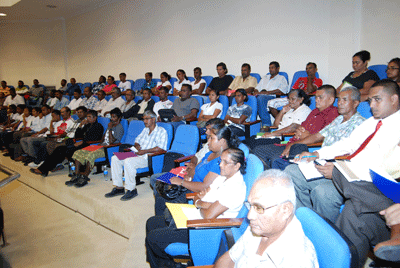THERE is good news for persons suffering with jaundice, diseases of the liver, kidney and other genitourinary problems.
 Amidst a seemingly uncontrollable upsurge of such diseases locally, with as many as 200 persons on the waiting list for surgery at the Georgetown Public Hospital, the good news has come that a magic herb with the potential to cure all such illnesses is grown right here in Guyana.
Amidst a seemingly uncontrollable upsurge of such diseases locally, with as many as 200 persons on the waiting list for surgery at the Georgetown Public Hospital, the good news has come that a magic herb with the potential to cure all such illnesses is grown right here in Guyana.
It grows 50 to 70 centimetres tal,l and bears ascending herbaceous branches. The bark is smooth and light green. It bears numerous pale green flowers, which are often flushed with red. The fruits are tiny, smooth capsules containing seeds. (Wikipedia)
The phyllanthus nururi, commonly known as ‘stone breaker’ or ‘seed-under-leaf, is known to be an ‘important plant of Indian Ayurvedic medicine’. As a traditional medicine, ithas been credited as being a fantastic remedy for problems of the stomach, genitourinary system, liver, kidney and spleen. Though it might have been around locally from time immemorial, the simple looking but wonder-working plant is reportedly as good today as ever it was for the treatment of such diseases, thereby tremendously reducing the burden of medical bills.
The story of the phyllanthus nururi, literally a tropical panacea, was shared with the Sunday Chronicle last week by Indian national Mr. Vaiyupur Durai, a Technical Advisor to a project working along with GuySuCo.
Dura, who has been visiting Guyana on work-related assignments over the last three years, turned up at the Guyana Chronicle last weekend evidently excited, optimistic and deeply gratified at the very thought of being able to help his fellow men make a breakthrough against some of the most difficult illnesses. He said in his country, India, stone breaker is used a lot for jaundice and also for Hepatitis ‘B’ and the control of HIV replication.
Proudly displaying the herb, Durai said, “You have it right here. It grows a lot on the coastland, and I’ve seen it so many places here.” He said that after having learnt of the magnitude of the problem of jaundice and genitourinary diseases locally, he felt compelled to share word of the ‘magical remedy’ with Guyanese.  Hours before visiting the Sunday Chronicle, Durai said, he called on Prime Minister Samuel Hinds and introduced the plant to him. And now he can’t wait to get the word out to the nation of Guyana!
Hours before visiting the Sunday Chronicle, Durai said, he called on Prime Minister Samuel Hinds and introduced the plant to him. And now he can’t wait to get the word out to the nation of Guyana!
When seeking to treat jauncide, Durai advised, pluck a single plant from the soil, wash it, and while it is still fresh, grind or blend and ingest the contents with fresh milk. He advises that it be taken in doses of about 10 to 20 ml, done preferably in the mornings for about three days.
The herb is also used for the treatment of scabies, in which case it is ground, a bit of salt is added to the juice, and the mixture is applied to the infected part of the skin.
Used as a treatment for gonorrhoea, leucorrhoa or menorrhagia, or other urinary complaints, the juice of the plant is used in doses of 45 to 50 ml. early in the mornings.
According to Wikipedia, the plant is also used in Brazil and Peru as a herbal remedy for kidney stones. Wikipedia advises that “A clinical study with Phyllanthus niruri indicated that it may reduce the levels of urinary calcium. A subsequent study of 150 patients over a six-month period indicated that an extract of this herb reduces the incidence of stone formation. The publication concluded, “Regular self-administration of P. niruri after extracorporeal shock wave lithotripsy for renal stones results in an increased stone-free rate that appears statistically significant for lower caliceal location. Its efficacy and the absolute lack of side effects make this therapy suitable to improve overall outcomes after extracorporeal shock wave lithotripsy for lower pole stones,”[the report said.
The report went on to say that, “A more recent rat study found that Phyllanthus niruri has been shown to interfere with many stages of stone formation, reducing crystals aggregation, modifying their structure and composition, as well as altering the interaction of the crystals with tubular cells, leading to reduced subsequent endocytosis.”
However, the page, last modified on March 23, 2013, says, “It is not clear that there have been any studies which conclusively found that Phyllanthus niruri was effective in treating existing stones.”
Experience has shown that there are cases locally where stones in the kidneys sometimes appear to multiply rapidly. In a classic example, a male patient presented at a local genitourinary clinic and was diagnosed as having two kidney stones. Oral treatment was initiated, pending the fixing of a date for the very delicate surgery. Within three months of waiting to have the surgery performed, further ultra sound and X-rays taken showed that there were five stones in the patient’s kidney, and no longer two.
Therefore, while phyllanthus nururi ‘might not be effective in splitting up or treating existing stones’, it can be expected to be effective in preventing the formation of fresh stones, Durai said.












